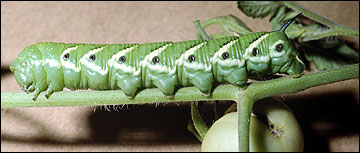Tobacco hornworm and tomato hornworm
Hornworms
 Tobacco hornworm caterpillars (Manduca sexta), left, and tomato hornworm caterpillars (Manduca quinquemaculata), below, are present from June through September. They produce two or more generations per year.
Tobacco hornworm caterpillars (Manduca sexta), left, and tomato hornworm caterpillars (Manduca quinquemaculata), below, are present from June through September. They produce two or more generations per year.

The caterpillars of both species are similar in appearance in that full-grown larvae are about 3 inches long and the body color tends to be light green (although dark green to brown forms may occur). The tobacco hornworm has seven oblique white lines on each side of its body. The upper borders of these lines are outlined in black, and the prominent horn (spine) at the posterior end of the body is usually red. However, the lateral white lines on the tomato hornworm are V-shaped and point toward the head; the lines are not outlined in black, but the horn tends to be black. Both species feed primarily on tomato and tobacco, although they have been known to feed on eggplant, pepper and potato.
About the family
Many caterpillar species in the Sphingidae family are referred to as hornworms because they have a conspicuous horn or spine on the top of the last abdominal segment. The bodies of these caterpillars are usually free of hairlike setae and smooth except for shallow wrinkles in each segment. Adults are referred to as sphinx, hawk, or hummingbird moths. They are fast, strong fliers with a rapid wing beat and often hover in front of a flower to feed on the nectar in much the same manner as a hummingbird (and superficially they look like a hummingbird too!). The name sphinx is probably in reference to the sphinx-like position that some of the caterpillars assume when disturbed. Some common vegetable, tobacco and other plant pests belong to this family of caterpillars.